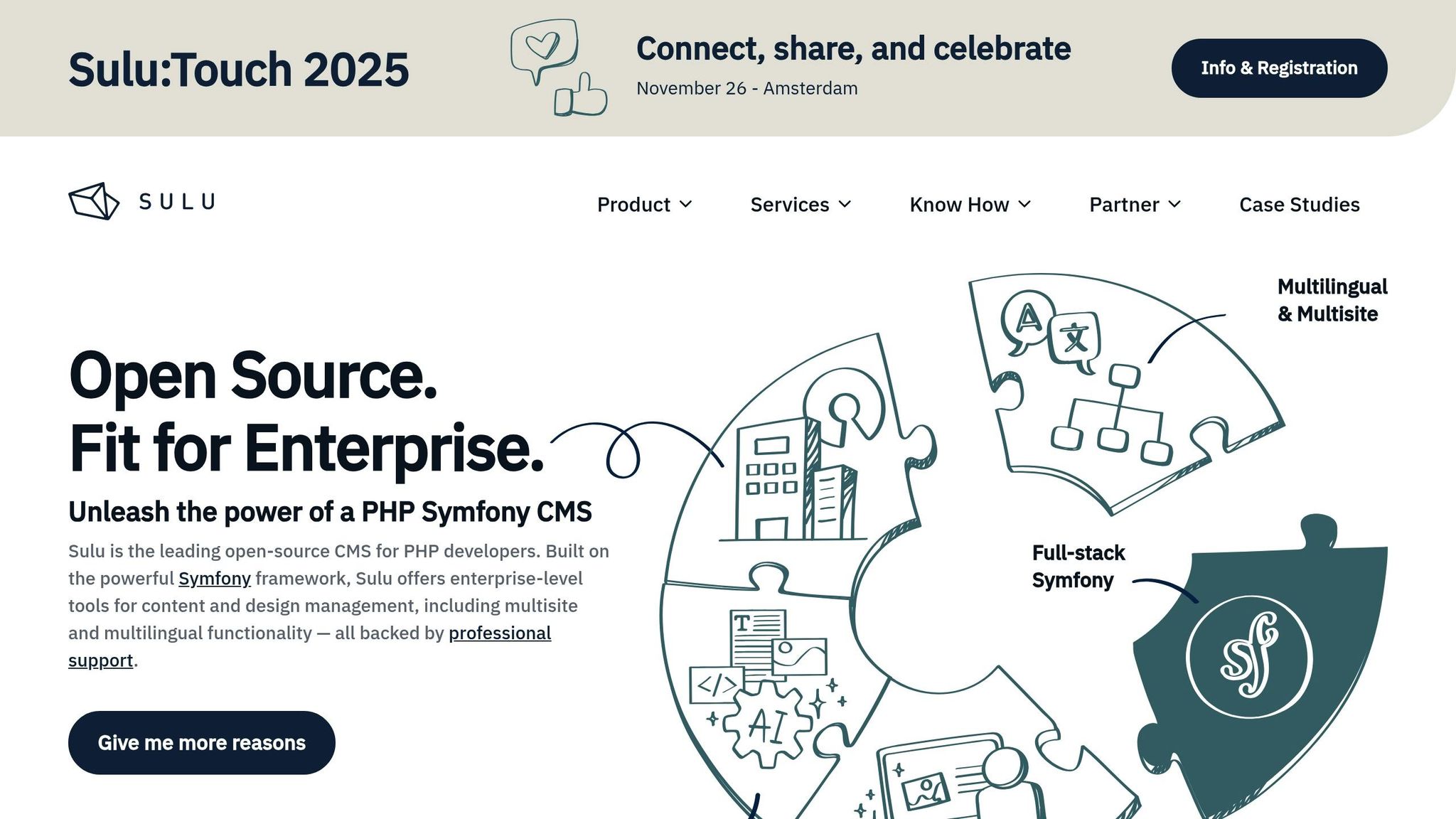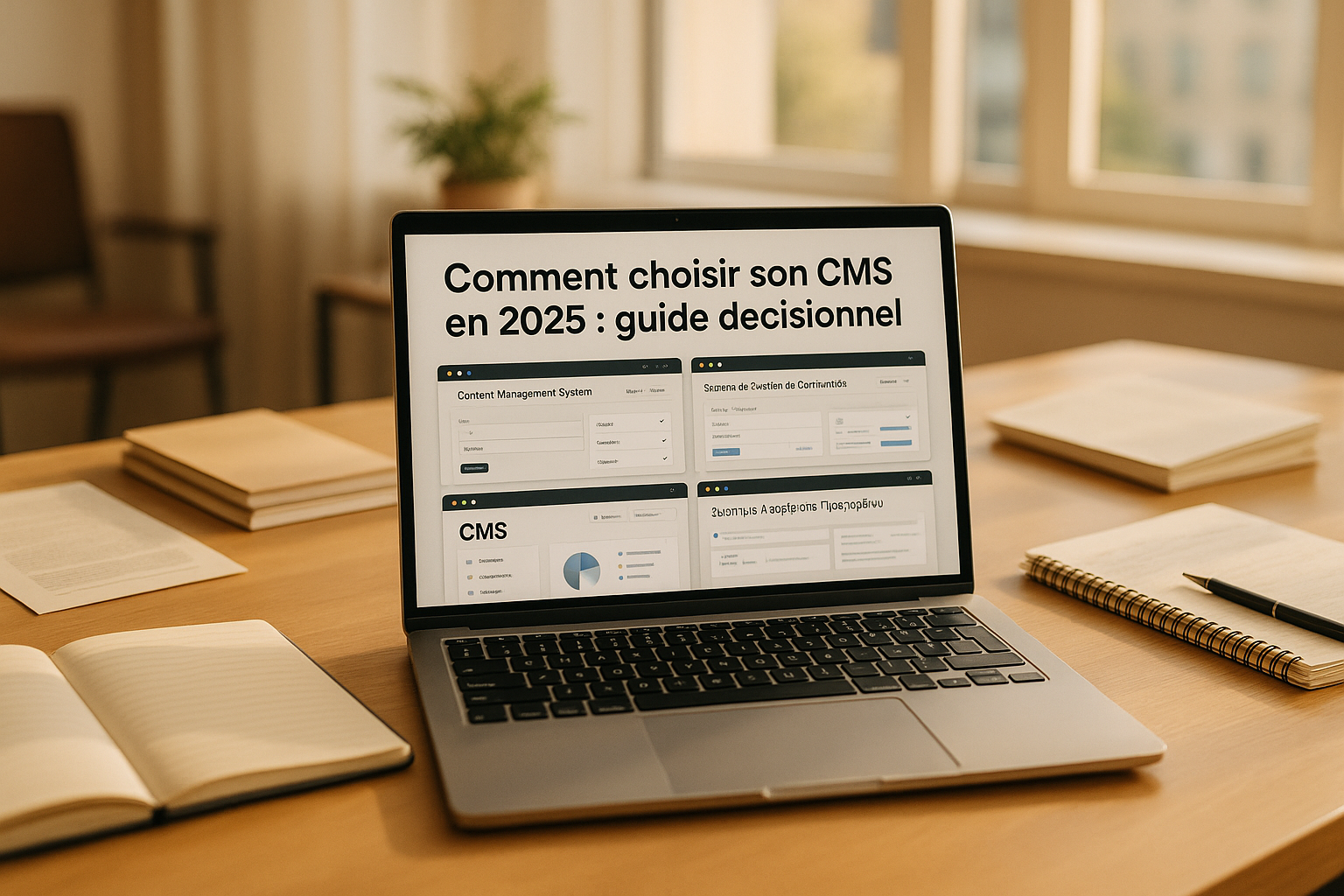How to choose your CMS in 2025: decision-making guide
How to choose your CMS in 2025: decision-making guide
In Switzerland, the (content management system) has become essential to meet specific needs:
- Multilingualism: With its 4 national languages, a site must efficiently manage multiple languages and respect local specificities.
- Compliance: The new Federal Data Protection Act (nDPA) imposes strict standards for security and confidentiality.
- : Swiss users seek fast, reliable sites adapted to their region (date formats, CHF currency, etc.).
Summary of main options:
- Sulu/Symfony: Ideal for complex and multilingual projects requiring tailored solutions. Offers advanced access rights management and robust integrations with other tools.
- WordPress: Popular solution for SMEs with simple needs. Accessible, cost-effective to install, but requires increased vigilance for security and performance.
Key points for choosing:
- Objectives: Multilingualism, e-commerce, showcase site?
- Resources: Budget, internal skills for technical management.
- Growth: Anticipate future needs (new languages, integrations, regulatory changes).
Guidance from local experts like can simplify this decision and ensure a solution tailored to the Swiss market.
Which CMS to choose for your website? 2025 comparison
Key criteria for choosing a CMS
To ensure the sustainability and security of your online activities, your CMS choice must meet data protection standards and offer reliable continuity. These needs translate into essential features, including:
Security and compliance
A good CMS must provide robust tools to protect user data and maintain your site's reliability. Here are the key elements to look for:
- Data encryption: User information must be secure and compliant with local data protection laws, such as GDPR [1].
- Rigorous access controls: Limiting user privileges enhances confidentiality and reduces the risk of unauthorized access [1].
- Automatic backups and restoration: These features are essential to cope with potential outages or attacks, ensuring a quick recovery of activities [1].
Sulu/Symfony: a modern CMS for tailored solutions

Sulu is a CMS based on Symfony, designed to meet the complex needs of Swiss companies. This platform is aimed at organizations looking for an advanced technical solution capable of adapting to evolving requirements.
Why Sulu is suited for Swiss projects
Thanks to its modular architecture, Sulu perfectly meets the needs of multilingual companies in Switzerland, whether in French, German, Italian, or English. This native language support avoids many technical complications often encountered with other systems.
Its clear separation between content and presentation allows developers to design elegant and high-performance user interfaces, while maintaining an intuitive interface for content editors. This approach ensures Swiss companies can combine technical expertise and editorial control without compromise.
In terms of security, Sulu stands out for its detailed access rights management. Each user can be assigned specific permissions, a crucial asset for Swiss companies where data protection is a priority. These robust technical features pave the way for a multitude of practical advantages.
Key features and advantages of Sulu
Sulu easily integrates with tools such as ERPs, CRMs, or external APIs, while allowing the structuring of complex content types. This capability is particularly useful for Swiss companies, which often rely on various specialized software in their daily activities.
Editors benefit from an interface that allows them to organize their content without worrying about technical aspects. Additionally, Sulu ensures fast loading times, even with large data volumes, directly improving user experience and SEO.
These technical characteristics have practical applications in various contexts.
Sulu in practice: usage examples
Sulu is ideal for complex corporate websites and multilingual portals requiring tailored features. Large Swiss companies particularly appreciate its ability to create secure internal portals, where each department can manage its content while respecting the overall visual identity. Native language management, including localized URLs and specific metadata, makes it an obvious choice for organizations operating in multiple language regions.
For Swiss NGOs and public institutions, Sulu offers a reliable and secure platform. It allows the design of robust institutional websites capable of handling high traffic volumes during important events, while protecting sensitive data.
Finally, Sulu effectively manages complex catalogs with differentiated pricing options, making it ideal for companies active in local and international markets. These examples show how Sulu positions itself as a tailored solution, before exploring WordPress, a popular alternative for SMEs.
sbb-itb-454261f
WordPress: a flexible option for SMEs

WordPress allows SMEs to establish a digital presence without requiring complex developments. This open-source CMS stands out as an ideal solution for companies with simple web needs, thanks to its balance between features and ease of use.
The advantages of WordPress
One of WordPress's main strengths is its basic free of charge. As an open-source solution, its core software is entirely free, allowing Swiss SMEs to launch their website with a controlled budget. Additional costs only concern hosting and, possibly, certain premium plugins or themes.
The WordPress plugin ecosystem is another strong point, especially for companies needing to manage multilingual content. Tools like WPML or Polylang simplify this task without requiring advanced technical skills. This aligns perfectly with the Swiss market expectations, where 76% of consumers prefer to buy products in their native language [2][3].
Furthermore, WordPress's intuitive interface allows internal teams to manage their content themselves. This autonomy reduces dependence on external developers, resulting in long-term savings, a significant advantage for SMEs with limited budgets.
The limitations of WordPress
Despite its many advantages, WordPress also has drawbacks. Its popularity makes it a frequent target for cyberattacks. About 90% of security vulnerabilities come from plugins and themes [4], expanding risks as the site grows. SMEs must invest in regular updates and appropriate security measures.
Performance issues can also be a hindrance. Excessive use of plugins, especially poorly coded ones, can significantly slow down the site. Each plugin adds code and server requests, which can harm loading speed, user experience, and SEO.
Finally, although WordPress is free to install, costs related to maintenance, updates, and monitoring can accumulate, burdening the budget in the long run. However, these challenges are less constraining for projects with simple needs.
When to use WordPress?
WordPress is particularly suitable for showcase sites requiring a clear presentation of services, especially in multiple languages. For corporate blogs or news, its intuitive interface facilitates editorial management.
In terms of e-commerce, WordPress combined with WooCommerce offers a quick and cost-effective solution for selling a limited number of products. However, for catalogs exceeding a hundred references or requiring complex integrations with ERPs, its limitations quickly become apparent.
Non-profit organizations and small Swiss associations also benefit from WordPress's advantages. Its ease of implementation and reduced costs perfectly meet their budget constraints, allowing them to communicate effectively with their members and donors.
In conclusion, WordPress meets the needs of Swiss SMEs for simple and controlled projects. However, the choice of CMS should be based on a thorough analysis of each company's specific needs.
How to adapt your needs to the right CMS
Choosing the ideal CMS may seem complex, but a methodical approach greatly facilitates this task. By following the steps below, you will be able to select the solution that best fits your specific needs while avoiding costly mistakes.
Step 1: Define your project's objectives
Start by clarifying your goals and the expectations of your target audience. In Switzerland, multilingualism is often a key factor. For example, a for an SME in Geneva will have very different needs from a targeting the European Union.
Also, think about your essential features. A simple site can rely on WordPress, while a more complex project requiring tailored solutions could benefit from Sulu or Symfony.
Step 2: Evaluate your internal resources
Analyze your team's technical skills and your overall budget. If you have , solutions like Sulu or Symfony can be considered. On the other hand, an SME without internal expertise might prefer WordPress for its simplicity.
Remember to consider all costs, not just the initial development. Maintenance, security updates, and future developments can quickly increase the budget, especially for complex sites.
Finally, think about daily content management. WordPress is intuitive and allows immediate autonomy, while more technical solutions often require thorough training.
Step 3: Anticipate long-term growth
A site that perfectly meets your current needs may not be enough to keep up with your growth. Think about scalability from the start: new markets, additional languages, integrations with other systems. If your company is expanding, investing in a solution like Sulu or Symfony can be more cost-effective in the long run.
Also, consider future needs for security and compliance. Swiss data protection laws are evolving, and your CMS must be able to adapt without requiring a complete overhaul.
Step 4: Consult experts for personalized recommendations
Faced with these multiple considerations, it may be wise to seek advice from a . For example, EWM SA, active since 2011, assists Swiss companies in choosing and implementing solutions tailored to the local market.
A Geneva agency understands the specific challenges of the Swiss context: multilingualism, regulatory compliance, and expectations of different language regions. Their expertise helps avoid common mistakes and optimize your investment.
A technical audit conducted by professionals can also reveal constraints you had not considered: necessary integrations, required performance, or technological developments to anticipate. These analyses will guide you towards a sustainable and tailored choice for your needs.
Conclusion: Choosing the right CMS for your digital success
After reviewing the criteria and tools available, it is time to summarize the essential elements for making an informed decision.
In Switzerland, where multilingualism and regulatory requirements are prevalent, the choice of your CMS in 2025 plays a crucial role. It directly influences , achieving your goals, and return on investment.
Key points to remember
Clarify your objectives, evaluate your resources, and plan your growth. In Switzerland, managing multiple languages is often essential, making this reflection step even more important.
WordPress and Sulu/Symfony remain solid and flexible options. These platforms, already mentioned, cater to both simple needs and tailored projects, thanks to their adaptability.
Prioritize a CMS capable of keeping up with regulatory and technological developments. The total cost of ownership includes much more than initial development. You must also consider security updates, maintenance, training, and future evolutions.
Why partner with

Making the right is a strategic decision, and specialized support can make all the difference. With the increasing complexity of technical and strategic considerations, the support of an expert agency becomes a key advantage.
Through its 360° approach, EWM SA offers comprehensive support: , deployment, and . This global expertise minimizes risks and maximizes your investment.
Since 2011, EWM SA, rooted in Geneva but internationally oriented, offers digital solutions tailored to companies of all sizes, from local SMEs to large organizations.
Choosing the right CMS lays the foundation for a promising digital future. With expert advice and professional implementation, your platform can become a real growth engine for the years to come.
FAQs
How to choose between Sulu/Symfony and WordPress to meet the specific needs of my company in Switzerland?
The decision between Sulu/Symfony and WordPress mainly depends on the specific needs of your company and the Swiss context. Here are some key elements to consider to make the right choice:
- Objectives and type of content: Is your site intended to be a simple showcase, a multilingual platform, or an online store? Each CMS excels in different areas. For example, WordPress is perfect for simpler sites, while Sulu/Symfony is better suited for complex projects requiring advanced features.
